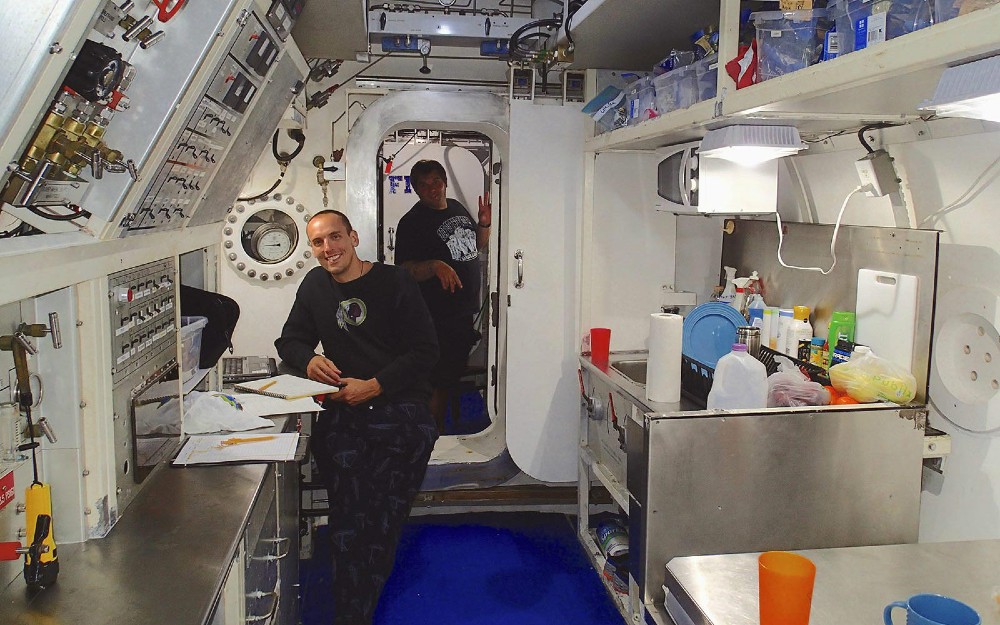No matter how the lab is used, continuous power and telecommunications capabilities make Aquarius an ideal platform for research projects, advanced sensor development, long-term monitoring of coastal oceans and coral reefs, and education and outreach. Web cameras operate during missions with cameras inside and outside Aquarius. Live broadcasts (webcasts and special video-conferencing opportunities) are often conducted involving schools, museums, and aquariums across the country.
Using a technique known as saturation diving, six Aquarius aquanauts (including two staff habitat technicians) can spend days to weeks underwater conducting research that cannot be accomplished anywhere else on the planet. Aquanauts diving from Aquarius can spend nine hours per day to depths of 95 feet with a reduced risk of decompression sickness, making Aquarius safe, efficient and cost effective.
Missions in Aquarius typically last ten days and aquanaut trainees undergo five days of specialized training before each mission starts. During missions a surface-based support crew monitors the aquanauts and habitat 24/7 from a watch desk and command center at the shore base. Divers are available round the clock for emergencies and a workboat goes out to the site almost every day.
Operating Environment
Aquarius is normally an ambient pressure habitat, which means that the interior atmospheric pressure is equal to the surrounding water pressure. The entryway within the Wet Porch, called the moon pool, remains open as the equal air pressure inside prevents the water from flowing in. The baseplate rests in approximately 62 feet of water, with the habitat mounted off the bottom at a depth of approximately 47 feet (tidal range at the site is between two and three feet). This operating depth is referred to as “hatch depth”. The pressure at 47 feet of seawater is about 2.5 times greater than the atmospheric pressure found at sea level. At this depth and pressure, nonsaturated visitors to Aquarius have less than about 80 minutes to visit and return to the surface before they risk experiencing decompression related illness. However, the mission aquanauts living in Aquarius can stay indefinitely and have nine hours of diving down to about 95 feet each day, with unlimited time at storage depth. At the end of a mission, aquanauts undergo 15 hours and 45 minutes of decompression that is conducted within Aquarius itself, while on the bottom. At the end of decompression, Aquanauts exit Aquarius and scuba dive back to the surface.
Length of an Aquarius Mission
Aquarius missions typically last 10 days, but have been as short as three days and as long as 31. We are currently exploring long-duration mission operations that extend beyond 40 days. One of the main benefits of saturation diving is that once you are saturated it doesn't matter if you stay one day, a week, or a month — the decompression time remains the same.
At the end of missions aquanauts decompress inside Aquarius, where pressure is slowly brought back to one atmosphere (or surface pressure) from the operating depth of about 50 feet — and it takes over 17 hours.
Aquanauts then "lock–out" and swim to the surface. People sometimes think that Aquarius is brought to the surface during decompression, but it stays on the bottom; it’s the pressure inside Aquarius that is changed.
In one atmosphere mode (1ATA), divers enter the habitat, hatches are secured and the internal pressure is returned to surface. Divers are sequestered inside Aquarius and cannot leave until the end of the operation, however, they can communicate with divers on the reef, conduct live videoconferences and experience an extended stay not possible on a single no-decompression dive from the surface. This mode of operation doesn't involve saturation diving and requires only a short training session beforehand. 1ATA operations are especially useful for conducting live education events (e.g., giving a course lecture or hosting multiple outreach events), real-time testing of sensors and equipment where direct interaction and observation is preferred and stable power and Internet connectivity are required, and for project development prior to launching a full saturation mission.
Visitors with approved science, education, outreach, research & development and media activities (film and radio) can use Aquarius for conducting live education events (e.g., giving a course lecture or hosting multiple outreach events), real-time testing of sensors and equipment where direct interaction and observation is preferred and stable power and Internet connectivity are required, project development prior to launching a full saturation mission and filming science and educational programming.
